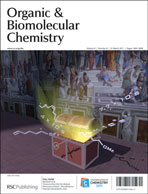This month sees the following articles in OBC that are in the top ten most accessed:-
A facile method for the synthesis of oxindole based quaternary a-aminonitriles via the Strecker reaction
Yun-Lin Liu, Feng Zhou, Jun-Jie Cao, Cong-Bin Ji, Miao Ding and Jian Zhou
Org. Biomol. Chem., 2010, 8, 3847-3850, DOI: 10.1039/C0OB00174K, Communication
Copper catalysis in the construction of indole and benzo[b]furan rings
Sandro Cacchi, Giancarlo Fabrizi and Antonella Goggiamani
Org. Biomol. Chem., 2011, 9, 641-652, DOI: 10.1039/C0OB00501K, Perspective
Chiral BINOL-derived phosphoric acids: privileged Brønsted acid organocatalysts for C–C bond formation reactions
Alexandru Zamfir, Sebastian Schenker, Matthias Freund and Svetlana B. Tsogoeva
Org. Biomol. Chem., 2010, 8, 5262-5276, DOI: 10.1039/C0OB00209G, Perspective
Borate esters as convenient reagents for direct amidation of carboxylic acids and transamidation of primary amides
Pavel Starkov and Tom D. Sheppard
Org. Biomol. Chem., 2011, 9, 1320-1323, DOI: 10.1039/C0OB01069C, Communication
1,2-Sulfone rearrangement in organocatalytic reactions
Adrien Quintard and Alexandre Alexakis
Org. Biomol. Chem., 2011, 9, 1407-1418, DOI: 10.1039/C0OB00818D, Paper
Reactions between Grignard reagents and heterocyclic N-oxides: Stereoselective synthesis of substituted pyridines, piperidines, and piperazines
Hans Andersson, Roger Olsson and Fredrik Almqvist
Org. Biomol. Chem., 2011, 9, 337-346, DOI: 10.1039/C0OB00336K, Perspective
Synthesis of substituted 8-aminoquinolines and phenanthrolines through a Povarov approach
Kavita De, Julien Legros, Benoit Crousse, Srinivasan Chandrasekaran and Danièle Bonnet-Delpon
Org. Biomol. Chem., 2011, 9, 347-350, DOI: 10.1039/C0OB00496K, Communication
Pd/Cu-catalyzed cascade Sonogashira coupling/cyclization reactions to highly substituted 3-formyl furans
Jingyu Yang, Chengyu Wang, Xin Xie, Hongfeng Li, Ende Li and Yanzhong Li
Org. Biomol. Chem., 2011, 9, 1342-1346, DOI: 10.1039/C0OB00985G, Communication
Highly sensitive detection of saccharides under physiological conditions with click synthesized boronic acid-oligomer fluorophores
Karimulla Mulla, Prateek Dongare, Ningzhang Zhou, Guang Chen, David W. Thompson and Yuming Zhao
Org. Biomol. Chem., 2011, 9, 1332-1336, DOI: 10.1039/C0OB01003K, Communication
Targeting DNA base pair mismatch with artificial nucleobases. Advances and perspectives in triple helix strategy
Vincent Malnuit, Maria Duca and Rachid Benhida
Org. Biomol. Chem., 2011, 9, 326-336, DOI: 10.1039/C0OB00418A, Perspective
Why not take a look at the articles today and blog your thoughts and comments below.
Fancy submitting an article to OBC? Then why not submit to us today or alternatively email us your suggestions.
Comments Off on Top ten most accessed articles in January












